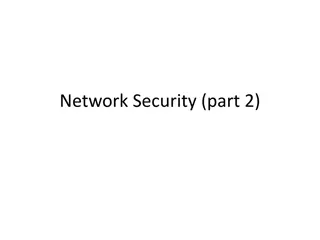
Exploring Network Address Allocation and DHCP in IPv6 Networks
Explore the importance of network address allocation in assigning unique identifiers to devices on a network, either manually or through DHCP. DHCP (Dynamic Host Configuration Protocol) automates the allocation of IP addresses, ensuring efficient network management and seamless data transmission. Learn about DHCP Discover and DHCP Offer messages in the process.
Download Presentation

Please find below an Image/Link to download the presentation.
The content on the website is provided AS IS for your information and personal use only. It may not be sold, licensed, or shared on other websites without obtaining consent from the author. If you encounter any issues during the download, it is possible that the publisher has removed the file from their server.
You are allowed to download the files provided on this website for personal or commercial use, subject to the condition that they are used lawfully. All files are the property of their respective owners.
The content on the website is provided AS IS for your information and personal use only. It may not be sold, licensed, or shared on other websites without obtaining consent from the author.
E N D
Presentation Transcript
1213 Network Defense Lecture 3 Part 2 # Exploring Network Technologies Exploring Network Technologies and Tools and Tools - Lecture 1 King Saud University Applied Studies and Community Service 1213
Network Address Allocation IPv6 128 bits fe80:0000:0000:0000:02d4:3ff7:003f:de62 DHCP Snooping DHCP Discover DHCP DHCP Offer DHCP Request DHCP Acknowledge DHCP DHCP DHCP - Lecture 1 King Saud University Applied Studies and Community Service 1213
Network Address Allocation is the procedure of assigning unique identifiers, such as IP addresses, to devices connected to a network. It ensures that each device has a distinct identity within the network, facilitating communication between devices both within the network and with external networks. This allocation can be done manually by network administrators or automatically using protocols like DHCP (Dynamic Host Configuration Protocol), which dynamically assigns addresses to devices as they connect to the network. Effective network address allocation is crucial for efficient network management and seamless data transmission. IP DHCP . . . .
DHCP stands for Dynamic Host Configuration Protocol. It's a network management protocol used on IP networks where a DHCP server dynamically assigns an IP address and other network configuration parameters to each device on a network so they can communicate with other IP networks. DHCP automates the process of assigning IP addresses to devices and helps prevent address conflicts that can occur when devices are manually assigned addresses. It's commonly used in home and business networks to simplify network administration. DHCP DHCP IP . DHCP IP . . .
DHCP Discover is a message sent by a computer or device seeking an IP address when connecting to a network. This message is broadcasted over the network to search for a DHCP server. The DHCP Discover message typically contains a broadcast address for the local network, informing the DHCP server that a new device needs an IP address. DHCP Discover IP DHCP. DHCP Discover DHCP IP. . DHCP Offer is a message sent by a DHCP server in response to a DHCP Discover message sent by a computer or device seeking an IP address when connecting to the network. This message is offered by the DHCP server to provide an IP address to the requesting device. Typically, the DHCP Offer message includes the proposed IP address for the device along with other network configuration information such as the server's address, default gateway address, and the proposed lease time for the IP address. DHCP DHCP DHCP Discover IP . DHCP IP IP DHCP IP .
Domain Name Resolution Use Case text - Understanding DNs DNS The main components of DNS include DNS Resolver: DNS Recursor (Resolver): Authoritative DNS Servers: Root DNS Servers - Lecture 1 King Saud University Applied Studies and Community Service 1213
DNS, which stands for Domain Name System, is a decentralized naming system used in networks, particularly the Internet, to translate human-readable domain names (such as www.example.com) into numerical IP addresses (such as 192.0.2.1) and vice versa. DNS enables users to access websites and other resources using easy-to-remember domain names rather than complex numerical IP addresses. It functions as a distributed database, distributing the responsibility of translating domain names to IP addresses across a network of DNS servers, which store and manage this mapping information. DNS plays a crucial role in facilitating communication and connectivity across networks by enabling efficient and user-friendly access to resources on the Internet and other networks. DNS ( DNS . . 192.0.2.1 ) DNS www.example.com) IP ( ( . IP). DNS IP
The Domain Name System (DNS) is a hierarchical and distributed naming system used to translate human-readable domain names (like www.example.com) into numerical IP addresses (like 192.0.2.1) and vice versa. The main components of DNS include: 1. DNS Resolver: The DNS resolver is a software component that runs on a user's device or network server and is responsible for initiating DNS queries to resolve domain names to IP addresses. DNS (DNS Resolver): DNS IP. 2. DNS Recursor (Resolver): The DNS recursor is a server that receives DNS queries from resolvers and is responsible for recursively resolving those queries by querying authoritative DNS servers and caching the results. DNS (DNS Recursor): DNS DNS .
3. Authoritative DNS Servers: These servers store and provide authoritative information about domain names and their associated IP addresses. There are different types of authoritative DNS servers, including primary (master) and secondary (slave) servers. DNS Authoritative DNS Servers): DNS . IP. ( 4. Root DNS Servers: These servers are the highest level in the DNS hierarchy and store the information about the top-level domain (TLD) servers responsible for each top-level domain extension (like .com, .org, .net). DNS ( Root DNS Servers): TLD) . DNS (
1.HTTP (Hypertext Transfer Protocol): Use Case: Used for transmitting hypertext over the Internet. It is the foundation of data communication for the World Wide Web. HTTP ( . : . :) 2.HTTPS (Hypertext Transfer Protocol Secure): Use Case: Similar to HTTP but adds a layer of security through SSL/TLS encryption. It's commonly used for secure communication over the Internet, particularly for sensitive data like login credentials and financial transactions. HTTPS ( :) : SSL/TLS. . Protocols and Use Cases HTTP 3.FTP (File Transfer Protocol): Use Case: Used for transferring files between a client and server on a computer network. It provides a straightforward method for uploading, downloading, and managing files. FTP ( . : . :) - Lecture 1 King Saud University Applied Studies and Community Service 1213
4. SFTP (SSH File Transfer Protocol): Use Case: Builds on SSH (Secure Shell) protocol to provide secure file transfer capabilities. It's commonly used for secure file transfer and remote file management over a network. SFTP ( SSH): . SSH ( : . ) 5. SMTP (Simple Mail Transfer Protocol):Use Case: Used for sending email messages between servers. It is a standard protocol for email transmission over the Internet. SMTP ( . . : :)
Basic Network Devices are essential components used to facilitate communication and connectivity within a computer network. These devices are fundamental building blocks of network infrastructure and play vital roles in managing and directing network traffic. Some common examples of basic network devices include: . : Router: ( :) Switch: ( :) Hub: ( ) Firewall: ( ) Access Point (AP): ( Modem: Understanding Basic Network Devices . AP) - Lecture 1 King Saud University Applied Studies and Community Service 1213
Router: A router is a networking device that forwards data packets between computer networks. It operates at the network layer of the OSI(Open Systems Interconnection) model and is responsible for directing traffic between different networks based on their IP addresses. . IP . OSI ) : ( Switch: A switch is a networking device that connects devices within the same local area network (LAN). It operates at the data link layer of the OSI model and forwards data packets between devices within the same network based on their MAC(Media Access Control) addresses. LAN). OSI ( MAC ) : . ( Hub: A hub is a simple networking device that connects multiple devices in a network. Unlike a switch, a hub broadcasts data packets to all connected devices, regardless of the intended recipient. . . ) : (
Firewall: A firewall is a network security device that monitors and controls incoming and outgoing network traffic based on predetermined security rules. It acts as a barrier between an internal network and external networks, such as the Internet, to prevent unauthorized access and protect against security threats. . . ) : ( Access Point (AP): An access point is a networking device that allows wireless devices to connect to a wired network. It serves as a central communication hub for wireless devices, providing access to network resources and facilitating wireless connectivity. AP): ( . . Modem: A modem is a device that modulates and demodulates digital data to enable communication between computers over a telephone line or cable network. It converts digital signals from a computer into analog signals for transmission over a communication medium and vice versa. . :
The basic components of switches include: Ports: Switching Fabric: MAC Address Table (CAM Table): Buffer Memory: Processor (CPU): Operating System (OS): Power Supply: Switches - Lecture 1 King Saud University Applied Studies and Community Service 1213
Switches contribute to network defense in several ways: : Port Security: Switches can enforce port security measures to restrict access to network resources. Port security features, such as MAC address filtering and port lockdown, prevent unauthorized devices from connecting to network ports and protect against MAC address spoofing attacks. MAC MAC. . : Spanning Tree Protocol (STP): STP is a network protocol supported by switches to prevent loops in Ethernet networks. By automatically detecting and blocking redundant paths, STP helps prevent network congestion and disruption caused by network loops, which can be exploited by attackers to launch denial-of-service (DoS) attacks. STP . . :
Quality of Service (QoS): Switches support QoS mechanisms to prioritize network traffic based on criteria such as application type, traffic volume, or specific user requirements. By prioritizing critical network traffic, switches ensure that essential services, such as VoIP or video conferencing, receive sufficient bandwidth and are less susceptible to performance degradation caused by network attacks or congestion. . : . Intrusion Detection and Prevention Systems (IDPS): Some advanced switches integrate features of IDPS to detect and block suspicious network activities in real-time. These switches can analyze network traffic patterns, detect anomalies indicative of potential attacks, and take automated actions to mitigate security threats, such as blocking malicious IP addresses or quarantining compromised devices. IDPS): IDPS . (
Central Processing Unit (CPU): Memory: Interfaces: Routing Table Routers and major Routers and major components components Forwarding Engine: Input/Output (I/O) Control: Operating System (OS): Power Supply: These components work together to enable the router to perform its core functions of routing packets between networks, managing network traffic, and ensuring reliable connectivity within the network infrastructure. .
Routers contribute to network security in several ways: : Virtual Private Networks (VPNs): Routers can establish VPN connections to securely connect remote users or branch offices to the corporate network over the Internet. VPNs use encryption to protect data transmitted over the network, ensuring confidentiality and integrity. VPNs): VPN . . ( Routing Protocol Security: Routers use routing protocols to exchange routing information and determine the best paths for forwarding packets. Implementing secure routing protocols, such as OSPFv3 with IPsec or BGP with BGPsec, helps protect against routing attacks by authenticating routing updates and securing routing communication channels. . . : OSPFv3 IPsec BGP BGPsec
Firewall Integration: Some routers integrate firewall functionalities to provide advanced security features such as stateful packet inspection, intrusion detection/prevention, and application-layer filtering. By combining routing and firewall capabilities, routers can offer comprehensive network security against various threats and attacks. . : . / .
Firewalls The major components of a firewall include: Packet Filtering: This component examines packets of data as they pass through the firewall and makes decisions about whether to allow or block them based on predetermined criteria such as source and destination IP addresses, ports, and protocols. IP . : Application Layer Filtering: This component operates at the application layer of the OSI model and inspects the contents of packets to identify specific applications or protocols. It can control access based on application-level attributes, allowing or blocking traffic based on the type of application being used. OSI . : . - Lecture 1 King Saud University Applied Studies and Community Service 1213
The major contributions of a firewall to network defense include: : Packet Filtering: Firewalls inspect packets of data as they pass through and make decisions to allow or block them based on predefined rules. This helps prevent unauthorized access and blocks malicious traffic. . . : Stateful Inspection: Firewalls monitor the state of active connections and make decisions based on the context of each connection. This allows them to better understand the nature of traffic flow and make informed decisions about allowing or blocking packets. . . : Application Layer Filtering: Firewalls can inspect the contents of packets at the application layer to identify specific applications or protocols. This allows them to control access based on application-level attributes, providing granular control over network traffic. . . :
Virtual Private Network (VPN) Support: Firewalls often support VPN technologies, allowing remote users to securely connect to the network over the internet. VPN support includes features for encryption, authentication, and secure tunneling, enhancing network security. VPN): VPN . . Intrusion Prevention System (IPS): Some advanced firewalls include IPS functionality to detect and block known and unknown threats in real-time. IPS systems analyze network traffic patterns and take automated actions to prevent security breaches ( IPS): IPS . IPS . (
End of Part Two - Lecture 1 King Saud University Applied Studies and Community Service 1213





















